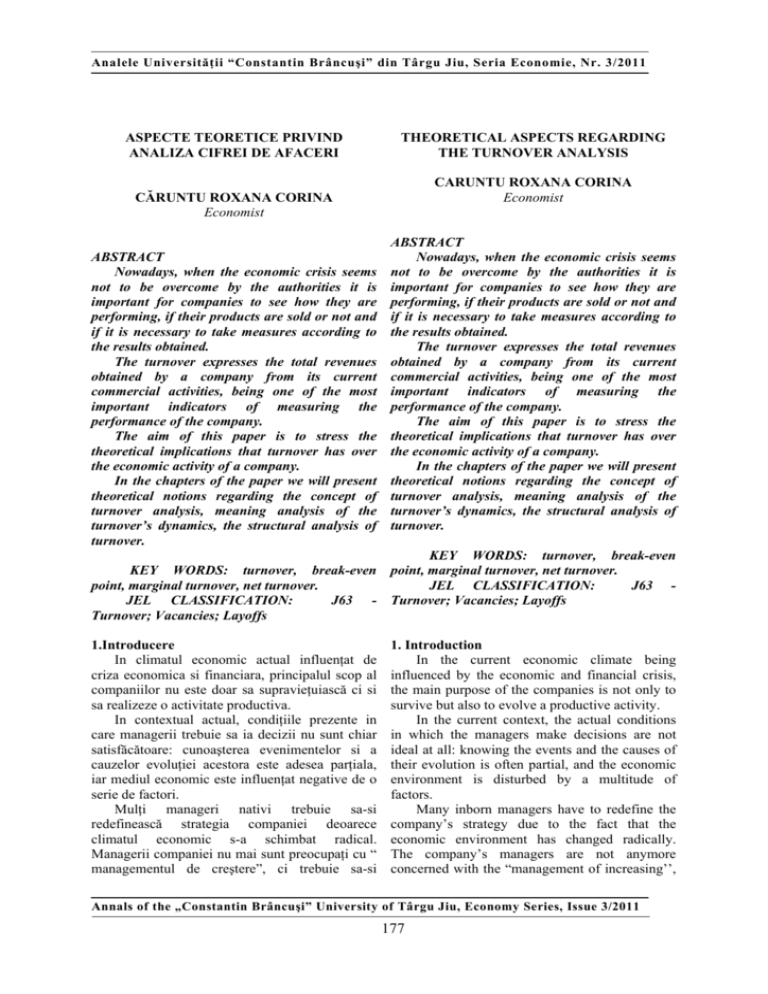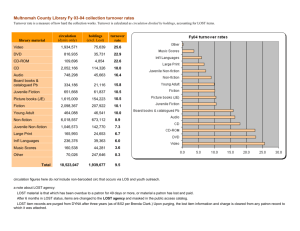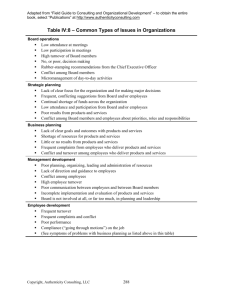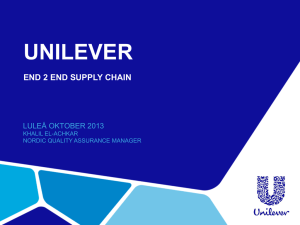ASPECTE TEORETICE PRIVIND ANALIZA CIFREI DE AFACERI
advertisement

Analele Universităţii “Constantin Brâncuşi” din Târgu Jiu, Seria Economie, Nr. 3/2011 ASPECTE TEORETICE PRIVIND ANALIZA CIFREI DE AFACERI THEORETICAL ASPECTS REGARDING THE TURNOVER ANALYSIS CARUNTU ROXANA CORINA Economist CĂRUNTU ROXANA CORINA Economist ABSTRACT Nowadays, when the economic crisis seems not to be overcome by the authorities it is important for companies to see how they are performing, if their products are sold or not and if it is necessary to take measures according to the results obtained. The turnover expresses the total revenues obtained by a company from its current commercial activities, being one of the most important indicators of measuring the performance of the company. The aim of this paper is to stress the theoretical implications that turnover has over the economic activity of a company. In the chapters of the paper we will present theoretical notions regarding the concept of turnover analysis, meaning analysis of the turnover’s dynamics, the structural analysis of turnover. ABSTRACT Nowadays, when the economic crisis seems not to be overcome by the authorities it is important for companies to see how they are performing, if their products are sold or not and if it is necessary to take measures according to the results obtained. The turnover expresses the total revenues obtained by a company from its current commercial activities, being one of the most important indicators of measuring the performance of the company. The aim of this paper is to stress the theoretical implications that turnover has over the economic activity of a company. In the chapters of the paper we will present theoretical notions regarding the concept of turnover analysis, meaning analysis of the turnover’s dynamics, the structural analysis of turnover. KEY WORDS: turnover, break-even KEY WORDS: turnover, break-even point, marginal turnover, net turnover. JEL CLASSIFICATION: J63 point, marginal turnover, net turnover. JEL CLASSIFICATION: J63 - Turnover; Vacancies; Layoffs Turnover; Vacancies; Layoffs 1.Introducere In climatul economic actual influenţat de criza economica si financiara, principalul scop al companiilor nu este doar sa supravieţuiască ci si sa realizeze o activitate productiva. In contextual actual, condiţiile prezente in care managerii trebuie sa ia decizii nu sunt chiar satisfăcătoare: cunoaşterea evenimentelor si a cauzelor evoluţiei acestora este adesea parţiala, iar mediul economic este influenţat negative de o serie de factori. Mulţi manageri nativi trebuie sa-si redefinească strategia companiei deoarece climatul economic s-a schimbat radical. Managerii companiei nu mai sunt preocupaţi cu “ managementul de creştere”, ci trebuie sa-si 1. Introduction In the current economic climate being influenced by the economic and financial crisis, the main purpose of the companies is not only to survive but also to evolve a productive activity. In the current context, the actual conditions in which the managers make decisions are not ideal at all: knowing the events and the causes of their evolution is often partial, and the economic environment is disturbed by a multitude of factors. Many inborn managers have to redefine the company’s strategy due to the fact that the economic environment has changed radically. The company’s managers are not anymore concerned with the “management of increasing’’, Annals of the „Constantin Brâncuşi” University of Târgu Jiu, Economy Series, Issue 3/2011 177 Analele Universităţii “Constantin Brâncuşi” din Târgu Jiu, Seria Economie, Nr. 3/2011 evalueze compania de la baza, începând chiar cu beneficiile oferite clienţilor. In vederea dezvoltării unei activităţi profitabile, managerii sunt obligaţi sa ia decizii si sa acţioneze rapid pentru a face fata constrângerilor economice si sociale actuale care au un impact asupra progresului companiei. Cifra de afaceri este considerata a fi un indicator fundamental al volumului activităţii unei companii si, in mod evident, este mereu luat in vedere atunci când se evaluează o companie. Folosind conceptul de cifra de afaceri avem posibilitatea sa tragem diferite concluzii referitoare la : ● poziţia pe piaţa a companiei; ● informaţii asupra dinamicii activităţii; detalii despre şansele de dezvoltare sau despre importanta companiei in sectorul de activitate; ● capacitatea de autofinanţare a firmei; ● capacitatea companiei de a dezvolta activităţi profitabile; but they have to assess the business from the ground starting even with the benefits offered to clients. For developing a profitable activity, managers are obliged to make decisions and act rapidly in order to face the current economic and social constraints which have an impact over the company’s progress. The turnover is considered to be a fundamental indicator of the volume of activity of a company and obviously it is always considered when evaluating a company. Using the turnover concept we have the possibility to draw different conclusions regarding: ● the market position of a company; ● information about the dynamics of the activity; about the chances of development or about the importance of the company in its sector of activity; ● the capacity of the company of auto financing itself, ● the capacity of the company to develop 2. Aspecte generale privind cifra de afaceri Conceptul de analiza a cifrei de afaceri poate profitable activities. fi abordat având in vedere următoarele rate: cifra de afaceri neta, cifra de afaceri medie, cifra de 2. General aspects regarding turnover afaceri marginala. The concept of turnover analysis can be Astfel, conceptul de analiza a cifrei de afaceri approached taking into consideration the presupune abordarea următoarelor rate following operational ratios: net turnover, average operaţionale: turnover, marginal turnover. The concept of ● cifra de afaceri neta( CA ) – reprezintă un turnover analysis can be approached taking into indicator al contului de profit si pierdere, compus consideration the following operational ratios: din veniturile totale obţinute din vânzarea ● net turnover( T ) – represents an indicator produselor si serviciilor din activitatea curenta a of the Profit and Loss Account, formed by total companiei, incluzând subvenţiile din investiţii, revenues obtained from the sale of goods and după deducerea comerţului cu reduceri. services from the current activity of the company, ● cifra de afaceri medie – cunoscuta si ca including the subsidies from investments, after preţul mediu de vânzare, reprezintă venitul deducting the trade discounts. obţinut din vânzarea unei unităţi si se calculează ● average turnover – also known as average selling price, represents the revenue obtained pe baza următoarei formule: from the sale of one unit of good or service and is CA CA = (1) computed using the following formula: Q T unde: Q reprezintă volumul fizic al vânzărilor T= (1) Q ● cifra de afaceri marginala ( CA m ) – exprima variaţia veniturilor din vânzări generate where: Q represents the physical volume of sales ● marginal turnover ( Tm ) – expresses the de creşterea cu o unitate a volumului fizic al vânzărilor si se calculează cu următoarea formula: variation of revenues from sale generated by the increase with one unit of the physical volume of ΔCA CA1 − CA0 (2) sales and is computed using the following CAm = = Q1 − Q0 ΔQ formula: ● pragul de rentabilitate ( BEP ) – Annals of the „Constantin Brâncuşi” University of Târgu Jiu, Economy Series, Issue 3/2011 178 Analele Universităţii “Constantin Brâncuşi” din Târgu Jiu, Seria Economie, Nr. 3/2011 reprezintă nivelul de rentabilitate a companiei si este nivelul veniturilor din vânzări necesare pentru acoperirea totala a cheltuielilor operaţionale. Formula de calcul porneşte de la ideea de baza ca in momentul atingerii pragului de rentabilitate, profitul este 0 iar cheltuielile totale in comparaţie cu volumul activităţii sunt grupate in cheltuieli fixe si variabile. BEP = ∑ FE 1 − RVE (3) unde: FE – reprezintă cheltuielile fixe R VE - reprezintă raportul cheltuielilor Tm = ΔT T1 − T0 = ΔQ Q1 − Q0 (2) ● break-even point ( BEP ) – represents the profitability level of the company and is the level of the sale revenues necessary for the total covering of the operating expenses. The computation formula was established from the basic idea that in the moment of reaching the break-even point, the profit is null and the total expenses as compared with the volume of activity are grouped in fixed and variable expenses. BEP = ∑ FE 1 − RVE (3) variabile, respectiv media cheltuielilor variabile la where: 1 RON cifra de afaceri, calculat folosind formula FE – represents the fixed expenses; următoare: R VE - represents the ratio of variable VE RVE = (4) expenses, respectively the average variable CA expenses to 1 ROL turnover, computed using the Cifra de afaceri se calculează din veniturile following formula: totale obţinute din livrarea bunurilor, furnizarea VE unor servicii si din venituri din alte operaţii, mai RVE = (4) T puţin rebuturile si reducerile oferite clienţilor. The turnover is calculated as the total Poate fi detaliata pana la nivelul produsului, revenues obtained from the delivery of goods, grupurilor de produse sau categoriilor de performing or providing some services and from activităţi. Astfel compania poate si trebuie sa fie other revenues from operations, less the rebates or interesata in cunoaşterea produselor cele mai other reductions offered to clients. It can be solicitate, ce contribuţie au la venituri si care sunt produsele cele mai profitabile. Creşterea cifrei de detailed until the level of the product, groups of afaceri reprezintă un obiectiv fundamental pentru products or categories of activities. In this way fiecare companie, obiectiv ce trebuie corelat cu the company can and has to be interested in knowing which of the products are more piaţa, cu dimensiunile si cu nevoile companiei. demanded, what contribution they have in the revenues and which products are the most 3. Analiza dinamicii cifrei de afaceri Aprecierea dimensiunii activităţii economice profitable. The increase of the turnover represents a a unei companii si modificarea acesteia in timp fundamental objective for any company, an sunt absolut necesare in atragerea si asigurarea objective that has to be correlated with the resurselor necesare pentru îndeplinirea market, the dimensions and the needs of the obiectivelor dorite. Pentru a analiza pe deplin company. activitatea unei companii, orice analiza a unui indicator trebuie sa includa o descriere dinamica a acestuia. Analiza evoluţiei in timp a cifrei de 3. The analysis of the turnover’s dynamics The appreciation of the dimension the afaceri poate fi realizata folosind modele statistice economic activity of a company and is clasice. modification in time is absolutely necessary for Studiul trebuie sa conţină informaţii aferente the procurement and assurance of necessary unei perioade de la 3 pana la 5 ani. Pe baza resources needed for the accomplishment of the concluziei obţinute in urma acestei analize pot fi stabilite strategiile de dezvoltare ale companiei desired objectives. To fully analyze the activity of pentru următorii ani, având in vedere factorii care a company, any analysis of any indicator must include a dynamic description of this one. The pot influenta activitatea companiei. Analiza dinamicii cifrei de afaceri pentru o analysis of the time evolution of turnover can be done using the classical statistical models. Annals of the „Constantin Brâncuşi” University of Târgu Jiu, Economy Series, Issue 3/2011 179 Analele Universităţii “Constantin Brâncuşi” din Târgu Jiu, Seria Economie, Nr. 3/2011 perioada de timp (0,n) se face pe baza: The study must contain information afferent ● abaterile absolute cu baza fixa sau cu baza to a period of 3-5 years. On the basis of the in lanţ: conclusion drawn from this analysis, there can be ΔCAFB = CAn − CA0 (5) established the development strategies of the company for the following years, taking into sau account the factors that can influence the activity ΔCACB = CAn − CAn −1 (6) of the company. ● indicii cu baza fixa sau cu baza in lanţ: The analysis of the dynamics of the turnover CAn for a time period (0, n) is done on the basis of: × 100 (7) I CA = ● Fixed- base (FB) or chained-base (CB) CA0 absolute changes: sau ΔTFB = Tn − T0 (5) CAn I CA = × 100 (8) or CAn −1 ΔTCB = Tn − Tn −1 (6) ● ratele de creştere cu baza fixa sau in lat: ● Fixed or chained-based ratios: CAn RCA = × 100 − 100 (9) T CA0 ITFB = n *100 (7) T0 sau CAn R = × 100 − 100 (10) or CA CAn −1 I TCB = ● ritmul mediu anual de creştere: ⎛ ⎞ CA RCA = ⎜ n −1 n − 1⎟ ×100 ⎜ ⎟ CA 0 ⎝ ⎠ (11) Analiza cifrei de afaceri pe o perioada lunga de timp oferă informaţii asupra activităţii unei companii si trendul acesteia. Cu scopul de a fi relevant in stabilirea strategiei de dezvoltare a companiei, dinamica firmei supuse analizei trebuie sa fie comparata cu dinamica pieţei si cea a sectorului de activitate. In cazul in care piaţa este mai dinamica decât compania, se va observa ca firma va pierde din cota de piaţă, fie din cauza creşterii vânzărilor competiţiei la un nivel ridicat, fie din cauza apariţiei pe piaţa a unor noi competitori. Pentru a realiza o analiza pertinenta a realităţii este necesara ajustarea indicatorilor nominali cu rata inflaţiei corespunzătoare sectorului de activitate al companiei. Comparaţia datelor in timp poate fi asigurata prin aplicarea procedurilor de inflaţie si deflaţie asupra indicatorilor. Deflaţia – implica exprimarea datelor din perioada analizata intr-o unitate monetara constanta, aferenta primului an, considerat ca baza. Ajustarea se face pe baza următoarele relaţii: CARn − m = unde: CACn − m I Pn − m / o Tn * 100 Tn −1 (8) ●Fixed or chained-based increase rate: R FB = I TFB − 100 (9) or RCB = I TCB − 100 (10) ●Annual average increase rate: R = ( n −1 Tn − 1) * 100 T0 (11) The analysis of turnover over a long period of time gives information about the activity of the enterprise and its trend. In order to be relevant for the establishment of the development strategy of the company, the dynamics of the analyzed company should be compared to the dynamics of the market and of the activity sector. If the market is more dynamic than the company, it will be noticed that the company will loose market share, either due to the increase of the sales of the competitors at a higher pace, or due to the entrance in the market of new competitors. For a pertinent analysis of the reality it is necessary to adjust the nominal indicators with the inflation rate corresponding to the activity sector of the company. The comparability of the data in time can be (12) insured by deflating or inflating the indicators. Deflation- implies expressing the data of the analyzed period in constant monetary units, Annals of the „Constantin Brâncuşi” University of Târgu Jiu, Economy Series, Issue 3/2011 180 Analele Universităţii “Constantin Brâncuşi” din Târgu Jiu, Seria Economie, Nr. 3/2011 CA R - reprezintă cifra de afaceri reala sau afferent to the first year, considered the base. The adjustment will be made on the basis of the comparabila; following relation: CA C - reprezintă cifra de afaceri curenta; TC n−m Ip n − m / o reprezintă indicele preţului, reportat TRn − m = (12) I Pn − m / o la primul an din perioada analizata. Inflaţia – implica aducerea la zi a valorilor where: indicilor la ultimul an al perioadei analizate, TR represents the real or comparable folosind următoarea formula: turnover; CARn − m = CACn − m * I Pn / n − m (13) T C - represents the current turnover; unde: Ip n − m / o represents the price index, reported Ip n / m − m - reprezintă indicele preţului, to the first year of the analyzed period. raportat la ultimul an al perioadei analizate Inflation – implies the bringing out to date of the value indexes to the last year of the analyzed 4 . Analiza structurii cifrei de afaceri period, using the following formulas: În analiza economico-financiară, o T (13) Rn − m = TC n − m * I Pn / n − m importanţă deosebită în determinarea cauzelor şi a rezervelor de creştere a cifrei de afaceri o are where: Ip n / m − m - represents the price index, reported studierea structurii vânzărilor. Structura cifrei de afaceri evidenţiază to the last year of the analyzed period. ponderea pe care o au anumite elemente in vânzările totale ale companiei. 4 .The structural analysis of turnover Din punct de vedere metodologic, analiza In the economic and financial analysis of structurii cifrei de afaceri se realizează prin: high importance in the determination of the 1. mărimi relative de structură–se causes and reserves of the increase in turnover is utilizează la determinarea ponderii deţinute de the study of the sale structure. diferite elemente (produse, mărfuri, servicii, The structure of the turnover emphasizes the activităţi, secţii etc.) în totalul cifrei de afaceri, weight of certain elements in the total sales of the utilizându-se următoarea relaţie: company. From the methodological point of view the ca (14) structural analysis of the turnover is realized gi = i ⋅ 100 CA through: unde: ●Determination of the weight of different gi - ponderea deţinută de categoria „i” în elements (products, merchandises, services, activities, departments, etc) in the total turnover, totalul cifrei de afaceri; cai - cifra de afaceri realizată de categoria by using the relative measurements of the structure: „i”; t CA–cifra de afaceri totală. (14) g i = i * 100 T 2. efectuarea de comparaţii ale structurii activităţii economice aferente mai multor exerciţii where: g i - represents the weight of “i “ category in financiare prin utilizarea coeficientul de concentrare Gini-Struck:: the total turnover; 2 n∑ gi − 1 t i - represents the turnover realized by “ i “ (15) G= category; n −1 T - represents the total turnover. unde: ● Making comparisons between the n– numărul de termeni ai seriei; gi - ponderea produsului sau grupei se structures of the economic activity afferent to different financial periods, using the Gini-Struck mărfuri „i” în cifra de afaceri. structure coefficient: Coeficientul Gini-Struck poate lua valori in Annals of the „Constantin Brâncuşi” University of Târgu Jiu, Economy Series, Issue 3/2011 181 Analele Universităţii “Constantin Brâncuşi” din Târgu Jiu, Seria Economie, Nr. 3/2011 intervalul [0, 1], având următoarea importanta: G--> arată că în structura vânzărilor sunt câteva produse care dau cea mai mare parte din cifra de afaceri, in alte cuvinte gradul de concentrare al activităţii este ridicat; G--> semnifică o distribuţie relativ uniformă a vânzărilor pe categoriile structurii activităţii. ● metoda ABC– este utilizată în principal pentru analiza structurii cifrei de afaceri pe produse, clienţi, furnizori. Utilitatea metodei ABC constă în definirea politicii de aprovizionare a firmei pe grupe (pentru comerţ) precum şi a puterii de negociere în raport cu clienţii/furnizorii (pentru toate domeniile). Produsele comercializate sunt cele care contribuie în proporţii diferite la realizarea cifrei de afaceri. Analiza curbei teoretice permite identificarea, în totalul produselor fabricate sau comercializate, trei grupe cu caracteristici specifice, astfel: subgrupă care cuprinde foarte puţine produse sau mărfuri, dar care realizează o mare parte din cifra de afaceri; două grupe care dau mai puţin de jumătate din cifra de afaceri, dar care controlează majoritatea produselor realizate şi respectiv comercializate. 4. Concluzii Evaluarea dimensiunii activităţii economice a comerciantului si schimbările acesteia de-a lungul timpului sunt absolute necesare in vederea procurării si furnizării resurselor necesare pentru obţinerea obiectivelor stabilite. In vederea îndeplinirii acestor aspecte, este necesara efectuarea unei analiza a evoluţiei cifrei de afaceri. Cifra de afaceri reprezintă un indicator capabil sa ofere o imagine asupra poziţiei pe piaţa a companiei, reprezentând volumul veniturilor dintr-o activitate intr-o perioada de timp, colectările realizându-se la preţul pieţei. Acest tip de indicator măsoară performanta companiei si se foloseşte des in calitate de criteriu pentru clasificarea companiilor pin funcţie de importanta lor economica. Creşterea cifrei de afaceri reprezintă obiectivul fundamental al oricărei companii, un obiectiv ce trebuie corelat cu piaţa, dimensiunile si nevoile companiei. 5. Bibliografie: G= n * ∑ g i2 − 1 n −1 (15) where: n - represents the number of terms of the series; g i -represents the structure of sales on categories of activities, groups of products, operating units etc. The Gini-Struck coefficient can take value in the interval [0, 1], having the following significance: •G--> means that in the structure of the activity of the company, a low number of the elements have an important weight in the turnover, or, in other words, the concentration degree of the activity is high. • G--> means that the sales are spread rather even between the categories of structure of the activity. ●ABC method–is mostly used for the analysis of the structure of the turnover on products, clients, suppliers. The usefulness of the ABC method consists in defining the supply politics of the company on groups (for commerce) as well as the negotiation power in comparison with the clients/suppliers( for all the domains). The commercialized products are those which contribute in different proportions to the realization of the turnover. The analysis of the theoretical curve allows the identification, in the total of the manufactured and commercialized products, of three groups with specific characteristics, as fallows: a subgroup which contains very few products or goods, but which contributes a lot to the turnover; two groups which give less than a half of the turnover, but which control the majority of the made and, respectively, commercialized products. 5. Conclusion Assessing the dimensions of the trader’s economic activity and its changes over time is absolutely necessary in order to purchase and provide the resources necessary to accomplish the proposed objectives. In order to do this, it is compulsory an analysis of the turnover evolution. The turnover is an indicator able to provide an insight into a company's market position, representing the volume of revenues from an Annals of the „Constantin Brâncuşi” University of Târgu Jiu, Economy Series, Issue 3/2011 182 Analele Universităţii “Constantin Brâncuşi” din Târgu Jiu, Seria Economie, Nr. 3/2011 1. Buse Lucian – “Analiza economicofinanciara”, Editura Economica, Bucuresti, 2005; 2. Cojocaru Constantin – “Analiza economico-financiara”, Editura Economica, Bucuresti, 2004; 3. Dinu Eduard – “Rentabilitatea firmei in practica”, All Beck, Bucuresti, 2004; 4. Ghic Gratiela, Grigorescu Carmen Judith – “ Analiza economico-financiara”, Editura Universitaria, Bucuresti, 2009; 5. Isfanescu Aurel, Robu Vasile, Hristea Ana Maria, Vasilescu Camelia – “Analiza economicofinanciara”, Editura Ase, Bucuresti, 2002; 6. Petcu Monica – “Analiza economicofinanciara a intreprinderii”, Editura Economica, Bucuresti, 2003; 7. Popescu Dan Dumitru – “ Creating value through company analysis (An approach for Romanian companies), H'ART Publishing Science, Bucharest, 2007; 8. Popescu Dan Dumitru – “Ghid pentru analiza financiara a companiilor industriale”, Editura Didactica si Pedagogica, Bucuresti,1986, H’Art Publishing Science, Bucuresti , 2007; 9. Stefea Petru – “Analiza rezultatelor intreprinderii”, Editura Mirton,Timisoara, 2002; 10. Valceanu Gheorghe, Robu Vasile, Dinu Eduard – “Analiza economica-financiara”, Editura Economica, Bucuresti, 2005. activity in a period of time, collections made at market price. This type of indicator measures the performance of a company and is regularly used as a criterion for classifying the companies based on their economic importance. The increase of the turnover represents a fundamental objective for any company, an objective that has to be correlated with the market, the dimensions and the needs of the company. 6. References: 1. Buse Lucian – “Analiza economicofinanciara”, Editura Economica, Bucuresti, 2005; 2. Cojocaru Constantin – “Analiza economico-financiara”, Editura Economica, Bucuresti, 2004; 3. Dinu Eduard – “Rentabilitatea firmei in practica”, All Beck, Bucuresti, 2004; 4. Ghic Gratiela, Grigorescu Carmen Judith – “ Analiza economico-financiara”, Editura Universitaria, Bucuresti, 2009; 5. Isfanescu Aurel, Robu Vasile, Hristea Ana Maria, Vasilescu Camelia – “Analiza economicofinanciara”, Editura Ase, Bucuresti, 2002; 6. Petcu Monica – “Analiza economicofinanciara a intreprinderii”, Editura Economica, Bucuresti, 2003; 7. Popescu Dan Dumitru – “ Creating value through company analysis (An approach for Romanian companies), H'ART Publishing Science, Bucharest, 2007; 8. Popescu Dan Dumitru – “Ghid pentru analiza financiara a companiilor industriale”, Editura Didactica si Pedagogica, Bucuresti,1986, H’Art Publishing Science, Bucuresti , 2007; 9. Stefea Petru – “Analiza rezultatelor intreprinderii”, Editura Mirton,Timisoara, 2002; 10. Valceanu Gheorghe, Robu Vasile, Dinu Eduard – “Analiza economica-financiara”, Editura Economica, Bucuresti, 2005. Annals of the „Constantin Brâncuşi” University of Târgu Jiu, Economy Series, Issue 3/2011 183







